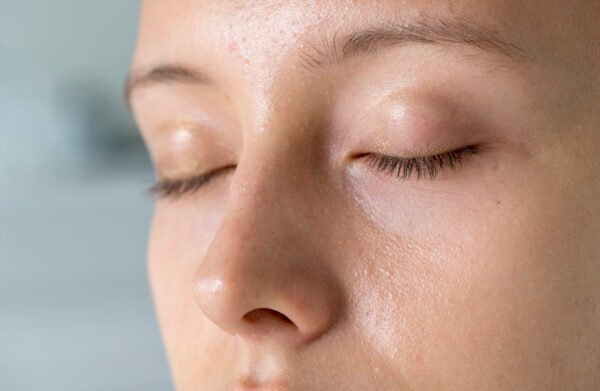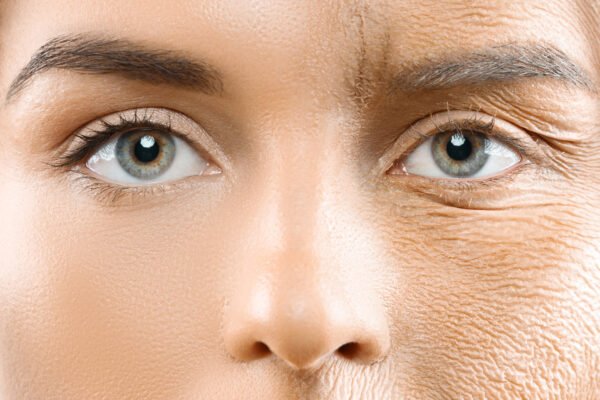The Enigma of Combination Skin
Combination skin confuses skincare aficionados. This uncommon skin type contains oily and dry traits, causing problems. Understanding this complicated skin type’s idiosyncrasies is crucial for beauty blog readers and people with it to preserve a healthy, radiant complexion. In this piece, we’ll look at the characteristics of combination skin and provide skincare methods to manage it.
If you have read our previous blogs about Combination skin, It’s time to provide you with the best routine for combination skin. This guide will help you a lot in managing your combination skin if you have this.
What Exactly is Combination Skin?
Having combination skin can be confusing. It’s not completely dry or sticky; it’s a mix of the two. Because of this, it can be hard to find the proper skincare schedule. People with mixed skin usually have an oily T-zone (forehead, nose, and chin) and dry spots on their lips and cheekbones. Recognizing these trends is essential for developing a personalized skin care plan.
Recognizing the Signs of Combination Skin
It would be best to have an excellent eye to spot mixed skin. One sign is having oily skin in the T-zone while other parts of your skin stay dry. This can make your forehead and nose look shiny, and your pores may get more extensive in those places. On the other hand, the lips may feel dry or tight, especially after washing them. Understanding these differences is the first step in making a good beauty practice.
Challenges Faced by Those with Combination Skin
Dealing with mixed skin is like balancing on a thin line. Take care of the oiliness without worsening the dryness; the same goes for the other way around. Strong cleaners could strip the skin, making it too dry, and rich creams could clog pores in oily areas. To balance the mixture of skin, you need to find items that work for both skin types.
The Science Behind Combination Skin
To understand the science behind mixture skin, you need to know how the production of oil changes in different parts of the face. The T-zone has more sebaceous glands, which makes the skin oily. Areas that are dryer make less sebum. Changes in hormones, the surroundings, and genes can all affect sebum levels, making it even harder for people with mixed skin to find the right skincare products.
Essential Skincare Tips for Combination Skin
Mixed skin requires a tailored skincare routine. Start with a gentle cleanser that removes grime and oil without drying skin. A toner may balance your skin’s pH and remove debris. Once or twice a week, exfoliation helps prevent blocked pores in oily regions without drying out cheeks. A solid timetable helps maintain equilibrium.
The Role of Moisturizers in Combination Skin Care
If you have mixed skin, picking the suitable lotion is very important. Light, oil-free products that hydrate the dry areas without overpowering the T-zone. Gel-based creams can work exceptionally well because they hydrate the skin and keep it from shining. Don’t be afraid to stack goods; a focused application lets you meet specific wants in different places.
Best Products for Combination Skin
It’s a big deal to find the best items for mixed skin. Search for items that won’t clog pores, which are called “comedogenic.” Hydrating ingredients like hyaluronic acid can keep skin from getting too oily, and salicylic acid can help control breakouts in the T-zone. Always read the ingredient lists to ensure your chosen products suit your face.
DIY Remedies for Combination Skin
Home treatments can be used in addition to store-bought items for people with mixed skin. You could use honey as a soft mask that moisturizes or aloe vera to calm itchy skin. Green tea can be a toner that makes the skin less oily and gives it antioxidants. These methods can be an excellent addition to your routine because they help you stay balanced and healthy.
Diet and Its Impact on Combination Skin
What you eat has a significant effect on how healthy your face is. Foods like salmon and peanuts, high in omega-3 fatty acids, can help keep your skin moist. Foods high in antioxidants, like fresh greens and nuts, protect against damage and swelling. Staining refreshed is also essential, so drink lots of water to keep your face healthy and strong.
Seasonal Changes and Combination of Skin
Seasonal changes can affect people with combination skin in different ways. If your skin is dry in the winter, you may need heavier creams to fight flakiness. On the other hand, if your skin is oily in the summer, you may need lighter, mattifying products. Your skin stays normal and healthy all year long if you change your skincare routine with the seasons.
The Importance of Consistency in Skincare
To take care of mixed skin, you need to be consistent. Sticking to a customized plan helps keep your skin balanced and takes care of problems that keep coming up. It takes a while to see significant changes, but sticking with it pays off. Monitor how your skin reacts to different items and change your routine for the best results.
Navigating Skincare Myths for Combination Skin
Myths about skin care can lead people with mixed skin astray. Some people think thick skin doesn’t need lotion, but skipping this step can worsen dry skin. Knowing the difference between fact and myth gives you the power to make intelligent decisions about your beauty routine, which will help your skin’s health and look.
The Role of Sunscreen in Combination Skin Care
Everyone, even people with mixed skin, must use sunscreen daily. Using a broad-spectrum sunscreen every day protects against UV rays that can make uneven skin tone worse and speed up the aging process. Look for light, non-comedogenic products that don’t clog pores for the best defense. It’s important to reapply sunscreen several times a day, especially when you’re outside.
How to Layer Products for Combination Skin
Product layering is essential for mixed skin. Use a mild cleanser and toner to balance. Apply moisturizing serums for dryness and T-zone breakout serums. Use a moisturizer and sunscreen in the morning or a rich night cream to hydrate overnight.
Understanding pH Balance and Its Effects
People with mixed skin are affected by skin care product pH. Your skin pH should be 4.5–5.5 for a nice layer. Products with high or low pH values may irritate skin and worsen oiliness or dryness. Choose pH-balanced cleansers and toners for sensitive skin.
Stress and Its Impact on Combination Skin
Stress may affect skin health, especially combination skin. Increased cortisol levels may disrupt sebum production, causing breakouts and irritation in the oily T-zone and dryness elsewhere. Stress-relieving methods, including mindfulness, exercise, and relaxation, help improve skin and health.
Choosing the Right Facial Masks
Adding facial creams to your routine can help if you have mixed skin. Clay clay masks can help remove oil and clear out p in the T-zone ores, while nourishing masks can feed dry skin. You might want to switch between different kinds of masks to get the best results from your treatment and meet your skin’s specific needs.
Conclusion
Because combination skin is a mix of oily and dry skin types, it needs careful care regarding skincare. By understanding your skin’s specific needs, you can create a practice that combines these different factors and keeps your skin healthy and glowing. To learn more about how to take care of mixed skin, you could talk to a doctor or ask other people interested in skin care for advice.







